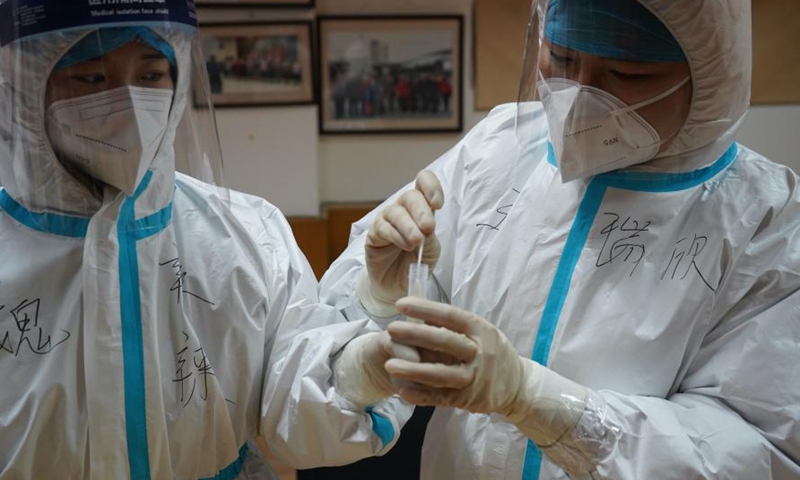The COVID-19 virus in Hebei was imported from abroad, worsening trend will stop soon: experts said

Medical workers seal a sample at a community in Yuhua District of Shijiazhuang, capital of north China's Hebei Province, Jan. 7, 2021. Shijiazhuang started to conduct citywide nucleic acid tests covering all residents on Wednesday. (Xinhua/Jin Haoyuan)
The virus causing the new COVID-19 outbreak in North China’s Hebei Province has been found to be imported from abroad, Hebei authorities said on Saturday. This has ruled out the possibility that it was related to previous local outbreaks in China.
The cases in this wave of Hebei outbreak are highly localized with patients mainly from rural areas. After sequencing the samples of many cases, it was found that the virus was an imported one, Shi Jian, an official from the Hebei Provincial Disease Prevention and Control Center, announced at the press conference held on Saturday afternoon.
Multiple clues are under close investigation. However, no specific conclusion has been made at present, Shi said.
“The high concentration of infections and no further significant spread brings people more confidence in containing this outbreak as fast as we can,” Wang Peiyu, deputy head of Peking University's School of Public Health, told the Global Times on Saturday, noting that this could further reduce the fear of a wider spread of the epidemic, but daily anti-epidemic measures should not be relaxed.
Wang said it was good to know that the virus is imported from abroad, as mutant viruses are usually more transmissible and pathogenic.
The first infected person may have been exposed to virus-positive people coming from abroad or materials, which still need to be investigated further. However, this still gives us a wake-up call in preventing both imported cases and internal spread, he noted.
A total of 247 positive COVID-19 cases were detected in the second round of nucleic acid testing conducted in Shijiazhuang, North China’s Hebei Province, less than the 354 cases that were detected in the first round, with most of the new cases coming from isolation medical observation sites, according to the conference.
About 91 percent of the positive cases are from Zengcun village and Xiguan village in epidemic-stricken Gaocheng district in Shijiazhuang,.
A total of 18 positive cases were detected in the second round of nucleic acid testing conducted in Xingtai, all of which were from isolation medical observation sites. Xingtai's epidemic is still confined to Nangong, a subcity in the city of Xingtai.
There is no further significant expansion of infections. Although the number of confirmed cases and positive cases are rising every day, most of the positive cases are close contacts or secondary close contacts of confirmed cases who have already been isolated. It shows the spread of the local epidemic has been brought under control to some extent, lowering public anxiety regarding undiscovered cases, Wang told the Global Times.
Shijiazhuang and Nangong city have extended their lockdown measures to January 19.
Nangong will take the severest lockdown measures starting from Saturday night. Residents are strictly quarantined at home and all working staff are forbidden to return home so they have to eat and live in their offices.
Local authorities are discussing whether to conduct the third round of testing. Wang believes that a third-round testing can be carried out in medium- and high-risk areas and among key groups, and there is no need to conduct citywide testing a third time.
Hebei reported 90 new confirmed local cases on Friday, with 83 in Shijiazhuang and seven in Xingtai. As of 10am on Saturday, 32 new confirmed cases were reported in Gaocheng district in Shijiazhuang.
Amid the new outbreak, 688 local confirmed cases had been reported in Hebei, including 646 in Shijiazhuang, 41 in Xingtai and one in Langfang, from January 2 to Saturday.
Based on existing studies, the incubation period of the virus is about two weeks, and the turning point of the epidemic in Hebei should be coming soon, Wang noted.
According to the official website of the National Health Commission, all of the recent outbreaks occurring in Hebei, Heilongjiang, Liaoning, Beijing, Sichuan are from overseas, which were caused by people coming from abroad or contaminated cold-chain imports. Important reasons for the outbreak spreading are non-standard management of isolation places and inadequate protection of workers who had contacts with imported cold-chain goods.
A total of 23 new confirmed cases were reported in Northeast China’s Heilongjiang Province on Friday, who are all linked to the infected people in epidemic-stricken Huiqi village, Wangkui county of Suihua city in the province.
Suihua and all counties under the city have set up epidemic consultation hotline to accept public appeals and information for help 24 hours a day.
Tonghua, Northeast China’s Jilin Province, reported 49 new cases of asymtomatic infection as of 10 am on Saturday, who are all close contacts, secondary close contacts of a training event..
Beijing reported two new confirmed COVID-19 cases in Shunyi district for Friday; there were no close contacts to the two patients, health officials said on Saturday.
As of 2 pm on Saturday, 104,907 drivers on the Didi Chuxing car-hailing platform in Beijing have made appointments for COVID-19 vaccinations, with 46,787 already inoculated, the company announced on its official Chinese Twitter-like Sina Weibo account.
